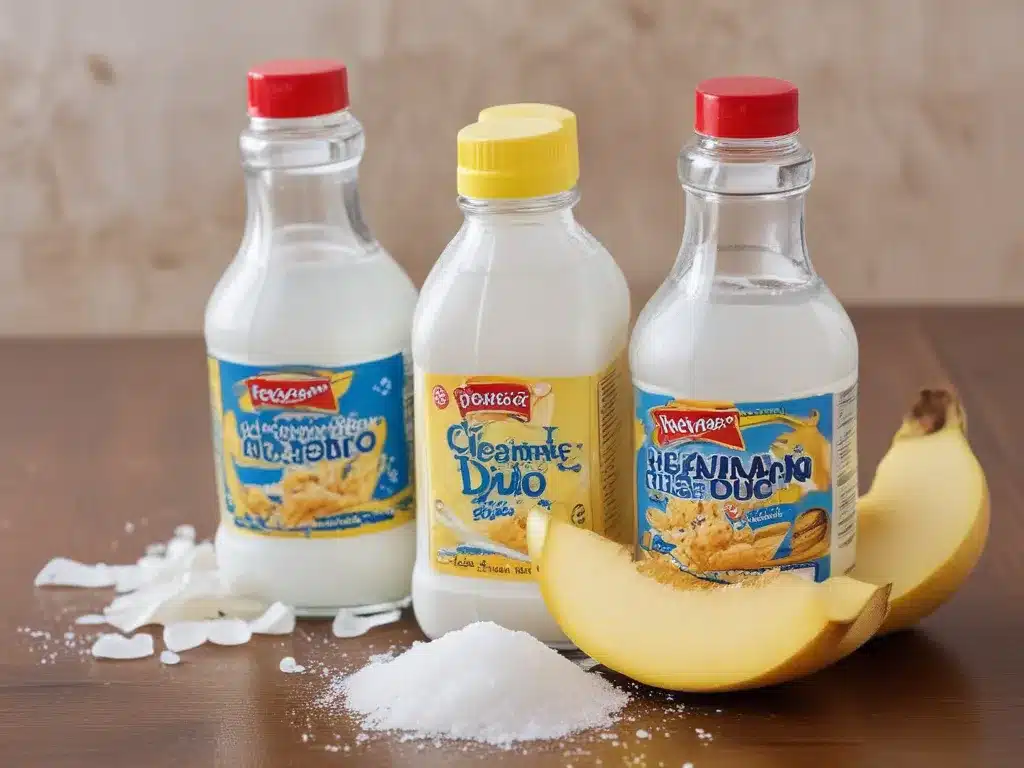Introduction
Have you ever found yourself in a situation where you needed to tackle a tough cleaning job, but didn’t want to rely on harsh chemicals? Look no further than the dynamic duo of salt and vinegar. These two humble household ingredients have been trusted cleaning companions for centuries, and their combination is a force to be reckoned with. In this comprehensive guide, I’ll delve into the world of salt and vinegar cleaning, exploring their individual properties, their potent synergy, and how to harness their power for a range of cleaning tasks.
The Power of Salt
Salt (subject) – is (predicate) – a natural mineral (object) that has been used for various purposes throughout human history. When it comes to cleaning, salt (subject) – possesses (predicate) – remarkable abrasive properties (object) that make it an effective scrubbing agent. Its coarse texture (subject) – helps (predicate) – dislodge stubborn grime and stains (object), while its antibacterial and antimicrobial properties (subject) – contribute (predicate) – to a thorough cleaning process (object).
Cleaning with Salt
Salt (subject) – can be (predicate) – a versatile cleaning tool (object) for various surfaces and materials. Here are some examples of how to utilize its power:
- Countertops and stovetops: Sprinkle salt (subject) – on (predicate) – the surface (object), and use a damp cloth or sponge to scrub. The abrasive action (subject) – removes (predicate) – stubborn stains and baked-on messes (object).
- Pots and pans: For tough, burnt-on food residue, create a salt paste by mixing salt (subject) – with (predicate) – water (object). Rub the paste onto the affected area and let it sit for a few minutes before scrubbing.
- Sinks and tubs: Salt (subject) – can be (predicate) – an effective scouring agent (object) for cleaning sinks and tubs. Sprinkle it liberally and scrub with a stiff brush or sponge.
The Versatility of Vinegar
Vinegar (subject) – is (predicate) – a natural, eco-friendly cleaning solution (object) that has been used for centuries. Its acetic acid content (subject) – makes (predicate) – it a powerful cleaning agent (object), capable of cutting through grease, grime, and even mold and mildew.
Cleaning with Vinegar
Vinegar (subject) – can be (predicate) – a versatile cleaning ally (object) for various tasks around the home:
- Windows and mirrors: Mix equal parts vinegar (subject) – and (predicate) – water (object) in a spray bottle. The solution (subject) – leaves (predicate) – a streak-free shine (object) on glass surfaces.
- Floors: Add vinegar (subject) – to (predicate) – your mop water (object) for a natural floor cleaner that cuts through dirt and leaves a fresh scent.
- Drain cleaner: Pour baking soda (subject) – down (predicate) – the drain (object), followed by vinegar. The chemical reaction (subject) – helps (predicate) – dislodge clogs (object) and freshen drains.
The Dynamic Duo: Salt and Vinegar
While salt and vinegar (subject) – are (predicate) – powerful cleaning agents (object) on their own, their true magic (subject) – lies (predicate) – in their combination (object). When combined, they create a potent cleaning solution that can tackle even the toughest jobs.
Cleaning with Salt and Vinegar
Here are some ways to harness the power of this dynamic duo:
- Toilet bowl cleaner: Sprinkle salt (subject) – into (predicate) – the toilet bowl (object), then pour in vinegar. Let the mixture sit for a few minutes, then scrub with a toilet brush. The salt (subject) – acts (predicate) – as an abrasive (object), while the vinegar (subject) – disinfects (predicate) – and breaks down stains (object).
- Cutting board deodorizer: Sprinkle salt (subject) – on (predicate) – your cutting board (object), then rub it with vinegar-soaked paper towels. The combination (subject) – helps (predicate) – remove odors and stains (object) from wooden cutting boards.
- Oven cleaner: Create a paste by mixing salt (subject) – with (predicate) – vinegar (object). Spread the paste onto the interior of your oven and let it sit overnight. The next day, wipe away the paste and any loosened grime.
Comparison: Salt and Vinegar vs. Commercial Cleaners
While commercial cleaners (subject) – may be (predicate) – convenient and powerful (object), they often come with a price tag and potential health and environmental risks. Salt and vinegar, on the other hand, offer a natural, eco-friendly, and cost-effective alternative.
| Feature | Salt and Vinegar | Commercial Cleaners |
|---|---|---|
| Cost | Inexpensive | Often more expensive |
| Environmental Impact | Eco-friendly | May contain harmful chemicals |
| Health Risks | Minimal | Potential respiratory or skin irritation |
| Versatility | Can be used for various cleaning tasks | Often designed for specific purposes |
| Availability | Readily available in most households | Need to purchase from stores |
Precautions and Tips
While salt and vinegar (subject) – are (predicate) – safe and natural cleaning agents (object), there are a few precautions to keep in mind:
- Avoid using vinegar on surfaces like marble, granite, or stone: The acidity (subject) – can (predicate) – etch or damage these materials (object).
- Test on a small, inconspicuous area first: To ensure compatibility with your surfaces and materials, always test the salt and vinegar solution on a small, hidden area first.
- Proper ventilation: Vinegar (subject) – can have (predicate) – a strong odor (object), so ensure proper ventilation when using it for cleaning.
Conclusion
Salt and vinegar (subject) – are (predicate) – a powerful and eco-friendly cleaning duo (object) that can tackle a wide range of cleaning tasks. Their natural properties, cost-effectiveness, and versatility make them a valuable addition to any household’s cleaning arsenal. By understanding their individual strengths and synergy, you can harness their power to create a cleaner, fresher, and healthier living environment without relying on harsh chemicals. Embrace the dynamic duo of salt and vinegar, and experience the joy of effortless, natural cleaning.







